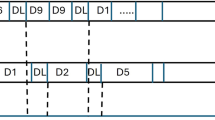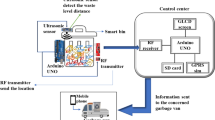Abstract
The mathematical modeling of IEEE 802.11 CSMA/CA has received considerable attention in the past few years. However there is lack of significant work considering the presence of buffer in wireless networks. Also most of the work has not followed IEEE specifications regarding inclusion of retry limits. This paper presents a new analytical model for performance evaluation of IEEE 802.11 single hop networks. The work presented here takes into consideration the presence of first order memory buffer along with the effect of traffic arrival which obeys Poisson distribution. In addition, we have considered the short retry limit to accommodate IEEE 802.11 specifications. On one hand, lack of buffering leads to high delays and under utilization of the channel. Also the absence of short retry limit tends to overestimate the throughput. By accommodating both the shortcomings, it has been proved that our model predicts the behaviour more accurately. We have been carrying out extensive simulations to validate results of our model. We have presented the performance evaluation of both the access mechanisms present in 802.11 MAC protocol.




















Similar content being viewed by others
References
IEEE 802.11. (1999). IEEE standard for wireless LAN wireless LAN medium access control (MAC) and physical layer (PHY) specifications: Higher-speed physical layer extension in the 2.4 GHz band. IEEE standard 802.11b, September 1999.
IEEE 802.11. (1999). IEEE standard for wireless LAN wireless LAN medium access control (MAC) and physical layer (PHY) specifications: Higher-speed physical layer extension in the 5 GHz band. IEEE standard 802.11a, September 1999.
Bianchi, G. (2000). Performance analysis of the IEEE 802.11 distributed coordination function. IEEE Journals on Selected Areas in Communication, 18(3), 535–547.
Chatzimisios, P., Vitsas, V., & Boucouvalas, A. C. (2004). Performance analysis of IEEE 802.11 DCF in presence of transmission errors. In Proceedings of IEEE communication society (pp. 3854–3858).
Yin, J. (2007). The analysis of performance of IEEE 802.11 MAC protocl using Markov chain. International Journal of Computer Science and Network Security, 7(12), 27–37.
Kumar, P., Rangaswamy, K. S., & Krishan, A. (2010). Saturation throughput analysis of IEEE 802.11b wireless local area network under high interference considering capture effects. International Journal of Computer Science and information Security, 7(1), 32–39.
Daneshgaran, F., Laddomada, M., Mesiti, F., & Mondin, M. (2007). Saturation throughput analysis of IEEE 802.11 in presence of non-ideal transmission channel and caputre effects. IEEE Transactions on Communications, 56(7), 1178–1188.
Ziouva, E., & Antonakopoulos, T. (2003). The IEEE 802.11 distributed coordination function in small-scale ad-hoc wireless LANs. International Journal of Wireless Information Networks, 10(1), 1–15.
Liaw, Y. S., Dadej, A., & Jayasuriya, A. (2005). Performance analysis of IEEE 802.11 under limited load. In Asia-Pacific conference on communications, IEEE, (pp. 759–763). Perth, Australia.
Daneshgaran, F., Laddomada, M., Mesiti, F., & Mondin, M. (2007). On the linear behaviour of the throughput of IEEE 802.11 DCF in non-saturated conditions. IEEE Communication Letters, 11(11), 856–858.
Lee, Y., Chung, M. Y., & Lee, T. J. (2008). Performance analysis of IEEE 802.11 under non-saturated condition. Mathematical Problems in Engineering, Hindawi Publishing Corporation.
Malone, D., Duffy, K., & Leith, D. (2007). Modelling the 802.11 distributed coordination function in nonsaturated heterogenous conditions. IEEE/ACM Transaction on Mobile Computing, 15(1), 159–172.
Malone, D., Duffy, K., & Leith, D. (2005). Modelling the 802.11 distributed coordination function with heterogenous finite load. In Proceedings of Workshop on Resource Allocation in Wirelss Networks.
Zhao, Q., Tsang, D. H. K., & Sakurai, T. (2009). A simple and approximate model for non-saturated IEEE 802.11 DCF. IEEE Transaction on Mobile Computing, 8(11), 1539–1553.
Dhanasekaran, S., & Krishan, A. (2010). Nonsaturation throughput enchancement of IEEE 802.11b distributed coordination function for heterogenous traffic under noisy environment. International Journal of Automation and Computing, 7(1), 545–569.
Daneshgaran, F., Laddomada, M., Mesiti, F., & Mondin, M. (2008). Unsaturated throughput analysis of IEEE 802.11 in presence of non-ideal transmission channel and capture effects. IEEE Transactions on Wireless Communications, 7(4), 1276–1286.
Daneshgaran, F., Laddomada, M., Mesiti, F., & Mondin, M. (2010). On the throughput performnace of mutirate IEEE 802.11 networks with variable loaded stations: Analysis, modeling and a novel proportional fairness criteria. IEEE Transactions on Wireless Communications, 9(5), 1594–1607.
Wu, H., Peng, Y., Long, K., Cheng, S., & Ma, J. (2002). Performance of reliable transport protocol over IEEE 802.11 wireless LAN: Analysis and enhancement. In Proceedings of IEEE INFOCOM, New York, USA (vol. 2, pp. 599–607).
Chatzimisios, P., Vitsas., V. & Boucouvalas, A. C. (2005). Performance analysis of IEEE 802.11 MAC protocol for WLAN. International Journal of Communication Systems, 18, 545–569.
Prakash, G., & Thangaraj, P. (2011). Non-saturation throughput analysis of IEEE 802.11 distributed coordination function. European Journal of Scientific Research, 51(2), 157–167.
Prakash, G., & Thangaraj, P. (2010). Throughput analysis of IEEE 802.11b WLAN under a non-saturated condition. In International conference and workshop on emerging trends in technology, Mumbai, India: ACM.
Kumar, P., & Krishan, A. (2011). Throughput analysis of IEEE 802.11 distributed coordination function considering erroneous channel and capture effects. International Journal of Computer Science and Information Security, 8(2), 236–243.
Huang, K. D., & Duffy, K. R. (2009). On buffering hypothesis in 802.11 analytic models. IEEE Communications Letters, 13(5), 312–314.
Duffy, K., & Ganesh., A. J. (2007). Modelling the impact of buffering on 802.11. Communication Letters, IEEE, 11(2), 219–221.
Dong, W., Zhang, W., Chen, X., & Wei, G. (2012). A new load equation for 802.11 MAC performance evaluation under non-saturated conditions. In First IEEE International Conference on Communication in China: Wireless Communication Systems, IEEE.
Li, T., Leith, D., & Malone, D. (2011). Buffer sizing for 802.11 based networks. IEEE/ACM Transactions on Networking, 19(1), 156–169.
Zhao, Q., Tsang, D. H. K., & Sakurai, T. (2011). Modelling nonsturated IEEE 802.11 DCF networks utilizing an arbitrary buffer size. IEEE Transaction on Mobile Computing, 10(9), 1248–1263.
Tickoo, O., & Sikdar, B. (2008). Modelling queueing and channel access delay in unsaturated IEEE 802.11 random access MAC based wireless networks. IEEE/ACM Transaction on Networking, 16(4), 878–891.
The VINT Project. (2010). The ns Mannual.
Author information
Authors and Affiliations
Corresponding author
Rights and permissions
About this article
Cite this article
Gupta, N., Rai, C.S. Performance Evaluation of IEEE 802.11 DCF in Single Hop Ad Hoc Networks. Wireless Pers Commun 79, 2171–2193 (2014). https://doi.org/10.1007/s11277-014-1979-5
Published:
Issue Date:
DOI: https://doi.org/10.1007/s11277-014-1979-5




